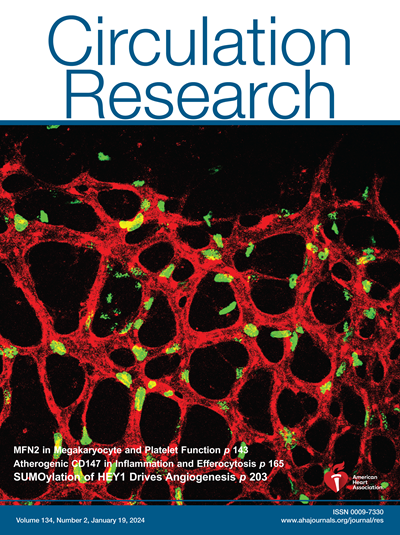Dicer Neosynthesis Regulates Platelet Reactivity: A Mechanism Altered in Type 2 Diabetes.
IF 16.2
1区 医学
Q1 CARDIAC & CARDIOVASCULAR SYSTEMS
引用次数: 0
Abstract
RATIONALE Despite being anucleate, platelets contain mRNAs and synthesize new proteins. Platelets also contain microRNAs and Dicer, an enzyme required for microRNA maturation. The expression of Dicer and some microRNAs is reduced in platelets from patients with type 2 diabetes (T2DM). However, the role of Dicer in the regulation of platelet function and in T2DM-associated platelet hyperreactivity is unclear. OBJECTIVE We aimed to assess whether Dicer levels are regulated in platelets upon activation, if they modulate mRNA translation by triggering pre-microRNA maturation, and whether these mechanisms are deranged in T2DM platelets. METHODS AND RESULTS Dicer expression was assessed by Western blotting, flow cytometry, and liquid chromatography-tandem mass spectrometry. The P2Y12 expression was assessed by Western blotting and microRNA-223 and P2RY12 (purinergic receptor P2Y12) transcript by real-time polymerase chain reaction. In vivo experiments were performed in Dicer-deficient and wild-type mice with alloxane-induced diabetes. Thrombin-activated platelets from healthy individuals rapidly neosynthesize Dicer, leading to increased maturation of microRNA-223 levels and concomitant consumption of pre-microRNA-223. An increase in microRNA-223 was associated with a reduction of P2RY12 mRNA, one of its main targets, and platelet P2Y12 expression and function. All these mechanisms were significantly deranged in platelets from patients with T2DM. Similar alterations were also observed in platelets from Dicer-deficient and diabetic mice. The Dicer-triggered decrease in P2Y12 after thrombin stimulation may represent a self-regulatory mechanism of platelet activation to prevent undesired thrombus formation, as shown by lower ADP-induced platelet pulmonary thromboembolism in mice previously infused with low-dose thrombin. The derangement of this self-regulatory mechanism in T2DM may contribute to the platelet hyperreactivity and enhanced thrombotic complications of patients with T2DM. CONCLUSIONS Our results show that the complex regulatory role of microRNA neoformation during platelet activation, when deranged, may contribute to cardiovascular disease.Dicer新合成调节血小板反应性:2型糖尿病改变的机制
理由:尽管血小板是无核的,但它含有mrna并能合成新的蛋白质。血小板也含有microRNA和Dicer,一种microRNA成熟所需的酶。2型糖尿病(T2DM)患者的血小板中Dicer和一些microrna的表达降低。然而,Dicer在调节血小板功能和t2dm相关血小板高反应性中的作用尚不清楚。目的:我们旨在评估血小板中Dicer水平是否在活化时受到调节,它们是否通过触发前microrna成熟来调节mRNA翻译,以及这些机制在T2DM血小板中是否紊乱。方法与结果采用Western blotting、流式细胞术、液相色谱-串联质谱法检测dicer的表达。Western blotting检测P2Y12的表达,实时聚合酶链反应检测microRNA-223和P2RY12(嘌呤能受体P2Y12)转录物的表达。在四氧嘧啶诱导的糖尿病小鼠中进行了dicer缺乏和野生型的体内实验。来自健康个体的凝血酶激活的血小板迅速新合成Dicer,导致microRNA-223水平的成熟增加和伴随的pre-microRNA-223的消耗。microRNA-223的增加与P2Y12 mRNA(其主要靶点之一)的减少以及血小板P2Y12的表达和功能有关。所有这些机制在T2DM患者的血小板中都明显紊乱。类似的改变也被观察到来自dicer缺陷小鼠和糖尿病小鼠的血小板。凝血酶刺激后,dicer引发的P2Y12降低可能代表了血小板活化的自我调节机制,以防止不希望的血栓形成,正如先前注射低剂量凝血酶的小鼠中adp诱导的血小板肺血栓栓塞降低所显示的那样。T2DM患者这种自我调节机制的紊乱可能导致T2DM患者血小板高反应性和血栓并发症的增加。结论血小板活化过程中microRNA新生的复杂调控作用一旦紊乱,可能导致心血管疾病的发生。
本文章由计算机程序翻译,如有差异,请以英文原文为准。
求助全文
约1分钟内获得全文
求助全文
来源期刊

Circulation research
医学-外周血管病
CiteScore
29.60
自引率
2.00%
发文量
535
审稿时长
3-6 weeks
期刊介绍:
Circulation Research is a peer-reviewed journal that serves as a forum for the highest quality research in basic cardiovascular biology. The journal publishes studies that utilize state-of-the-art approaches to investigate mechanisms of human disease, as well as translational and clinical research that provide fundamental insights into the basis of disease and the mechanism of therapies.
Circulation Research has a broad audience that includes clinical and academic cardiologists, basic cardiovascular scientists, physiologists, cellular and molecular biologists, and cardiovascular pharmacologists. The journal aims to advance the understanding of cardiovascular biology and disease by disseminating cutting-edge research to these diverse communities.
In terms of indexing, Circulation Research is included in several prominent scientific databases, including BIOSIS, CAB Abstracts, Chemical Abstracts, Current Contents, EMBASE, and MEDLINE. This ensures that the journal's articles are easily discoverable and accessible to researchers in the field.
Overall, Circulation Research is a reputable publication that attracts high-quality research and provides a platform for the dissemination of important findings in basic cardiovascular biology and its translational and clinical applications.
 求助内容:
求助内容: 应助结果提醒方式:
应助结果提醒方式:


